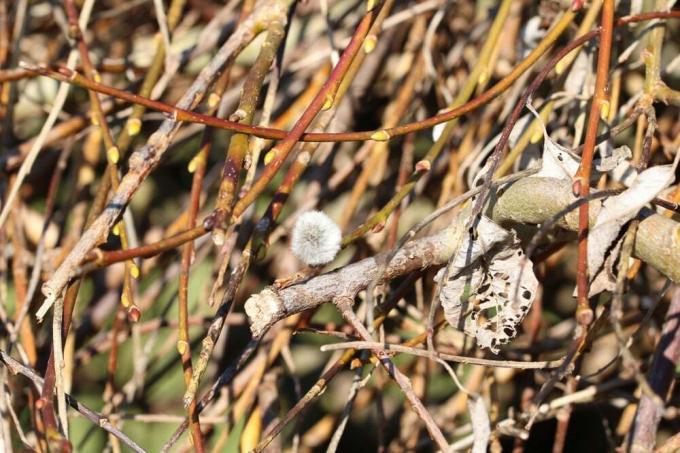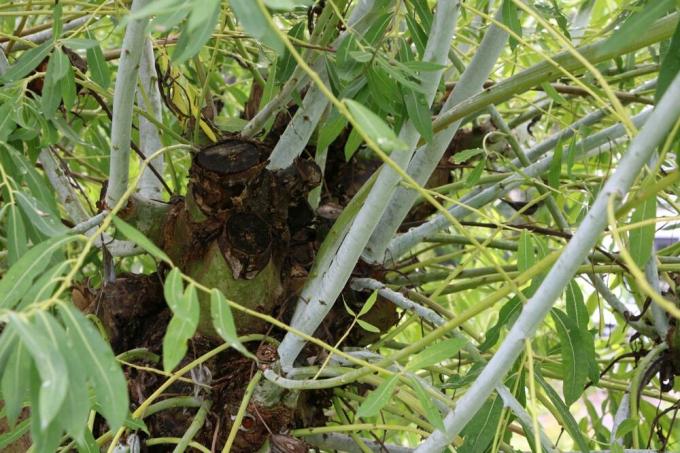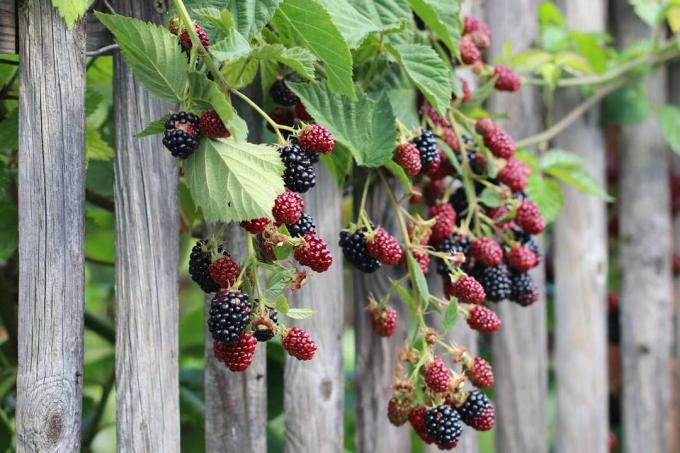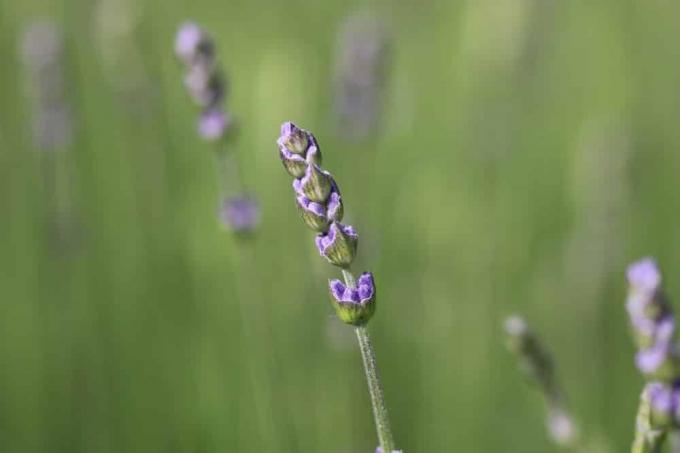

Table of contents
- substrate and soil
- Plant
- watering and fertilizing
- use
- diseases and pests
- Conclusion
- Worth knowing shortly
Willows are versatile and indestructible, they can be used as hedges, but they are also popular in forestry as a fast-growing raw material. If you want to put a willow tree in the garden or want to plant a hedge as a border, you can easily use willow cuttings. They grow quickly and are easy to cultivate. Here we explain how it works best.
substrate and soil
Willow cuttings can be cut directly from the mother tree. The length depends on the purpose for which they are intended. Even long shoots root quickly, provided that they are not purely green branches, the bark should already be woody. Cuttings are cut off with a sharp knife around June or July. These are placed in the water where most willow species will root relatively quickly. With some types of willow, simply sticking them in the moist soil is enough. Still others root even wrapped in a damp cloth. However, it makes sense to root them in water, so the development can also be followed. After that they can be put in place.
The varieties have proven to be particularly easy to grow Salix purpurea, Salix caprea and Salix alba. They all offer a pleasant sight in spring with the so-called pussy willows. In addition, their strongly branched roots strengthen the soil down to a depth of two meters, so that they are often planted along the bank to strengthen the soil. Cuttings of white willow, Salix alba and cracked willow are particularly suitable for this purpose. Salix fragilis.
- Willow cuttings do not require a special substrate
- cut the cuttings at an angle from the mother plant
Plant
There are willows of almost all sizes, some more than 30 meters high. For a hedge, for example, cuttings no higher than 20 cm are sufficient. They can be pruned as early as the first year after planting after they have established themselves, so that they branch out well. A willow as a standard can be produced by a cutting of 50 to 80 cm. If you want a living fence with intertwined willows, the cuttings should be more than a meter long to get into the right shape right away. The silk willow and polar willow are particularly suitable as living fences or braided hedges, as they do not grow too tall as dwarf shrubs. Your kittens are a feast for the eyes in spring and a real paradise for bees.
Due to the strong, well-branched roots, willows can also be used to stabilize a slope. Plant a number of cuttings directly into the soil, providing adequate water without overcrowding Waterlogging occurs, and after just a few weeks the young roots of the cuttings have more grip on the ground give.
- Never cut pussy willow branches Salix caprea in the wild, they are under nature protection!
- Cut back your willows after flowering, then they will branch out well.
- Arctic willow and silk willow can be planted relatively close together, after just a few years they form a dense hedge.
Tip:
Before cutting, think about what purpose you want your pasture to serve. Used as a hedge or living fence, it will require regular trimming and may need braiding. As a solitary plant, it needs a lot of space over the years. As a container plant, it is only suitable to a limited extent.
watering and fertilizing

You can observe the cuttings in the water, roots will sprout within a few days, so that the young plants can be planted in the ground. Thanks to the vigor, the willow will get bigger quite quickly, but that also means that it takes a lot of nutrients from the soil in the first few years, although it is known as a frugal plant is. Here it is advisable to fertilize young plants once in the first two to three years to stimulate growth, after which the plant takes care of itself. The soil must not dry out completely, in dry phases it should be watered. Willows thrive best in well-drained soil and require plenty of water.
use
In earlier times, the willow branches were used for basket weaving, but also for the construction of half-timbered houses. This required large quantities of rods that were always freshly cut. For this reason, pollard willows were cultivated, which produce numerous long shoots on their thick trunks. Pollarded willows are still an impressive sight today and not that difficult to produce. They are particularly suitable as a property boundary, but require some maintenance. Willow cuttings for a pollarded willow can be a bit larger and thicker, white willow and osier are well suited. The cuttings are cut radically at a height of one to three meters, so that the first branched shoots soon appear. This head cut must be repeated regularly so that the characteristic head is created.
- Willow rods as a decorative element are a real eye-catcher, even in the home
- Willow branches can be used as support sticks in the garden
- thicker willow rods can be used as posts and stems
- Willow cuttings can also be used as a trellis, excellent for low varieties of peas or sweet peas
- if you want to prevent the sticks and posts from regrowing, remove the bark
Tip:
If you have a large garden, then plan a covered garden path. Place willow cuttings along the garden path once the pliable canes are established and have shot up a bit you can tie them together at the desired height where they are then trimmed to flatten as desired branch. This living tunnel can also be filled with climbing roses or clematis.
diseases and pests
Like most plants, willow can be damaged by fungal diseases. Therefore, when cutting the cuttings, make sure that no spots appear. Willow rust in particular can affect all types of willow, it looks like orange flour and is quite easy to spot.
Conclusion
Willow cuttings are rewarding plants that can be rooted without much effort. Whether in the water or firmly in the ground, they show an incredible urge to grow. Due to the enormous vitality of most willow species, cuttings grow even under unfavorable conditions. The diverse possibilities of the fast-growing plants, from the pure ornamental plant to the living fence, make the willow an indispensable plant in our gardens.
Worth knowing shortly
- Willow is propagated by cuttings. You cut them in summer, i.e. in July or August.
- Remove a branch from a willow tree or shrub and cut it into pieces about 20 cm long.
- The branch should be lignified and no longer green. Put the pieces in a glass filled with water.
- The water should be changed every few days. Small roots will soon begin to grow.
- When they are big enough, you can take out the willow cuttings and plant them.
You can put the rooted cuttings as described above straight into the garden or you can plant them in a pot first. You can also plant unrooted cuttings, also in a pot or straight into the garden.
- Rooted cuttings: The rooted cuttings are planted in a suitable spot in the garden. You can save yourself the detour via a planter, because the willows usually grow without any problems and grow out quickly. The soil should be kept slightly moist at first, but only slightly. Standing wetness must be avoided at all costs. Once the cuttings have grown properly, you can leave them to themselves. Willow is absolutely frugal and easy to care for. You really don't have to do anything other than cutting.
- Unrooted cuttings: The cuttings are simply placed in suitable soil. The approximately 20 cm long pieces are pushed deep into the ground so that about 2 to 3 cm protrude from the plant substrate. Water well and make sure the soil doesn't dry out. The substrate can be slightly damp, but must never be wet. Weeds should be removed regularly.

When planting unrooted cuttings, it is important not to plant them the wrong way round. The lower end must be in the ground, otherwise roots will not form. When cutting the cuttings, you can make sure that the lower end is cut straight and the upper end is cut diagonally. This is how you avoid mistakes.
- As described above, willow cuttings are best cut in summer.
- You cut off a piece of branch that is as thick as possible or a whole strong willow branch.
- The stronger this piece, the stronger the new willow. They should be thumb thick, thicker is also good.
- For the cuttings, a 20 cm long piece is enough. But you can also plant the entire branch, depending on what you want to do with it.
 garden editorial
garden editorial I write about everything that interests me in my garden.
Learn more about pruning

Eucalyptus dried up: cut back now?
When a eucalyptus dries up, some owners immediately think of cutting it back. Because they want to see fresh green bud quickly. The chances of that happening may be good. But one thing must not be left out: research into the causes! Otherwise a new cycle of drying up and cutting begins.

Cut blackberries: Instructions for the right cut
Bramble branches only bear fruit for one summer, after which they are used up and die off in winter. It's a good thing that new canes grow back in time for the following year. Cutting care means: What no longer supports should be removed, young rods must be optimally trained.

cutting snowball | 13 tips for pruning
When it comes to snowballs (Viburnum), the opinions of numerous hobby gardeners differ when it comes to cutting. Main reason against pruning: Destruction of the natural appearance by pruning. Find out now when it is unavoidable and which tips should be heeded.

Cutting sage: 6 tips for cutting back
Cutting measures and their ideal time depend on the species of sage plants, because they have differentiated ways of life. There are woody and herbaceous representatives that require different attention. In order to carry out the measures, a basic set of tools is helpful.

Pruning hydrangeas: when is the right time?
Hydrangeas are a real beauty because of their flowers. In the long term, however, the flowering power is only maintained if regular pruning takes place. Because cutting off withered or dried plant parts offers protection. The following guide shows when this measure should be taken.

Cutting Lavender | When is the best time?
Lavender is a popular perennial, but difficult to cut. Without regular pruning, the shrub becomes lignified and less robust. Choosing the right time is important for pruning. When to cut depends on the use of the perennials.
